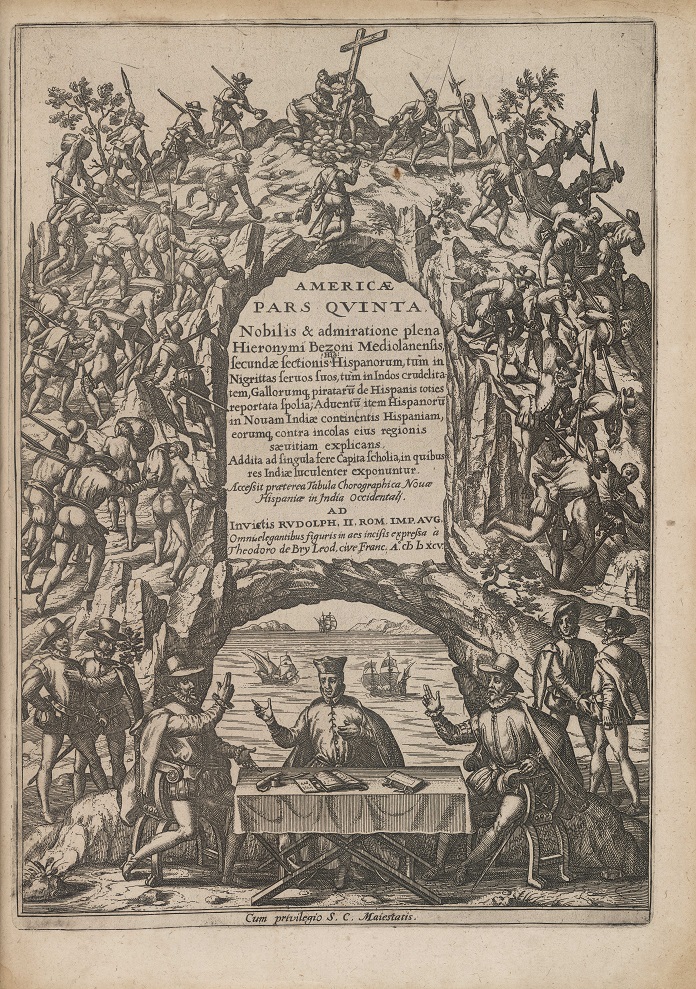Canary Islands
Suze van Dijken
This contribution is published in both Dutch and English. You will find the English version below.
| Nummer Koeman’s Atlantes Neerlandici, vol. II | 8970:2 |
| Titel kaart / Titel tekst | INSULÆ CANARIÆ / De Canarische Eylanden |
Tot de Canarische eilanden worden in de tijd van Joan Blaeu de eilanden Palma, Hierro, La Gomera, Tenerife, Gran Canaria, Fuerteventura en Lanzarote gerekend. Blaeu vindt de kleinere eilanden weinig belang hebben en benoemt ze verder niet. Informatie achterwege laten lijkt een trend te zijn in de tekst die Blaeu opnam over de Canarische eilanden, waarbij het de vraag is of dit een bewuste keuze was of niet.
Zo vermijdt Blaeu de bespreking van de verovering van de Canarische eilanden door Spanje. Hij heeft het maar één keer in de tekst over een strijd die tussen de Spanjaarden en de oorspronkelijke bevolking zou hebben plaatsgevonden. Hier noemt hij ze “barbaren” en gaat niet in op hoe de strijd om de eilanden nu exact verliep. Waarom refereert Blaeu niet aan deze evenementen, terwijl hij wel de beschikking had kunnen hebben over deze informatie? Tussen 1565 en 1727 verschenen er namelijk maar liefst 11 edities van Historia del Mondo Nuovo van Girolamo Benzoni (circa 1519-1572). Deze Italiaanse avonturier heeft in zijn boek veel aandacht voor de wreedheid die hij in Amerika aantrof en is vooral kritisch op de Spaanse hebzucht en mishandeling van de oorspronkelijke bewoners. In Benzoni’s hoofdstuk over de Canarische eilanden beschrijft hij een aantal van de gewelddadige botsingen tussen de Spanjaarden en de bevolking. Over de slag bij het eiland La Gomera: ‘Landing a hundred and twenty men there, they (the Spanish) were attacked with such courage and ferocity by the natives, that the greater part of them were killed.’

Jacques Le Moyne, Brevis narratio eorum quae in Florida Americae Provincia Gallis acciderunt (Frankfurt am Main: Johann Wechel, 1591): the title page of part five, which mentions the cruelty of the Spaniards towards the indigenous population.
De lange periode van verovering, nederlaag en uiteindelijke kolonisatie door de Spanjaarden wordt door Blaeu slechts summier beschreven. Opvallend is dat Blaeu een link legt tussen de geleidelijke bekering tot het christendom en de aard van de oorspronkelijke bewoners, die hierna verzachtte. De “barbaren” waren oorspronkelijk namelijk ‘oorlogszuchtig’. In deze beschrijving schuilt impliciet Europees superioriteitsdenken. Er wordt geïmpliceerd dat door het aannemen van het christelijke geloof ze een trede op de beschavingsladder stegen.
Maar of dat proces nu wel zo vredig verliep als Blaeu suggereert…?
Suggestie om verder te lezen:
Benzoni, G. and W. Smyth (ed.) (2010). History of the New World, by Girolamo Benzoni of Milan: Shewing His Travels in America, From A.D. 1541 to 1556. Surrey: Ashgate.
Bibliografische opmerking: Translated from the text originally published at Venice, 1572. The supplementary material consists of the 1857 annual report. This is a digital edition of the volume first published in 1857.
| Koeman’s Atlantes Neerlandici, vol. II | 8970:2 |
| Title map / Title text | INSULÆ CANARIÆ / De Canarische Eylanden |
In Joan Blaeu’s time, the Canary Islands comprised the islands of Palma, Hierro, La Gomera, Tenerife, Gran Canaria, Fuerteventura, and Lanzarote. Blaeu did not attach much relevance to the smaller islands and left them unmentioned. Omitting information seems to be a trend in his text about the Canary Islands Blaeu included and the question is whether or not this was intentional.
Blaeu does not, for instance, discuss Spain’s conquest of the islands. There is just one reference in his text to the alleged struggle between the Spanish and the indigenous peoples, whom he here calls ‘barbaren’ [barbarians], without addressing the process of conquest and colonization. Why did Blaeu not go into greater detail on these events? He definitely could have known what went on, for instance from the no fewer than 11 volumes of Historia del Mondo Nuovo [The History of the New World], a book by Girolamo Benzoni (ca. 1519-1572), (re)published several times between 1565 and 1727. In his book, Benzoni, an Italian historian and traveller, gives detailed first-hand accounts of the cruel Spanish colonial practices in America, criticizing the colonizers’ greed and brutal treatment of the indigenous population. In his chapter on the Canary Islands, Benzoni describes a number of violent clashes between the Spanish and the indigenous peoples. He wrote the following about the Rebellion of La Gomera <translated from the Italian>: ‘Landing a hundred and twenty men there, they (the Spanish) were attacked with such courage and ferocity by the natives, that the greater part of them were killed.’
Blaeu barely touches upon the long period of conquest, defeat, and ultimately Spanish colonization. Interestingly, he makes a connection between the gradual conversion to Christianity and the nature of the indigenous peoples, who became more docile after having become Christians. The ‘barbarians’ had initially been ‘oorlogszuchtig’ [belligerent]. This description reflects the European notion of superiority. It is implied that by converting to Christianity the indigenous peoples would morally and ethically improve, making them more ‘civilized’.
But was this process really as peaceful as Blaeu would suggest…?
Further reading:
Benzoni, G. and W. Smyth (ed.) (2010). History of the New World, by Girolamo Benzoni of Milan: Shewing His Travels in America, From A.D. 1541 to 1556. Surrey: Ashgate.
Bibliographical note: Translated from the text originally published at Venice, 1572. The supplementary material consists of the 1857 annual report. This is a digital edition of the volume first published in 1857.
